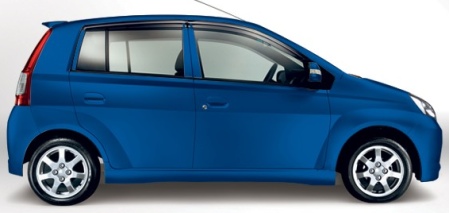Now I know the range of Perodua Viva thinking of going to buy some Perodua 1000cc instead of considering the purchase of premium top myvi. So, I'll do a little comparison here. If you will add something to contribute to the debate and please post a comment.
Power
Interestingly, it is a 1.0-liter Perodua myvi of the DVVT ej - VE engine torque than a larger Perodua Viva DVVT ej is the same as the VE is expected to be 1.0 liter engine. Contrast, only 1.0 liters of myvi 3,600 rpm Viva is 88 nm min, 3,600 rpm with torque of 90nm to defend - if 2Nm only minor differences.
Since then, myvi 1.0 Perodua Viva 1.0 liters a clear winner in terms of power / weight ratio, so that, myvi 1.3 instead of 1.0 Viva let's compare premiums. myvi 1.3 955 kg weight is 86 to hold the horsepower. This is the power per kilogram weight ratio of 0.09 hp. What Perodua Viva Premium 1000cc, 60 kg weight and 800 horsepower to remove - there are 0,075 power per kilogram weight-horsepower ratio.
So we can conclude that in a drag race, the Viva won’t be able to smoke it’s larger sibling in stock form. That doesn’t mean the Viva is terribly slow – in a previous supermini shootout done together with folks at NST Life & Times, I found that the Myvi effortlessly smoked other superminis with larger 1.5 liter engines.
Another note is that Perodua myvi is 1.3 liters 4-cylinder engine and four-cylinder engine is smoother and more three-cylinder engine found in Perodua Viva are using more. This is the end, perhaps, you are in the chassis and steering wheel feels that in many other respects the three-cylinder vibration.
Fuel
Perodua's own charts gasoline per 1 liter 1000cc Premium Perodua Viva 17.5 kilometers, according to combined cycle, I need to drive in a lot of leg crossing and motorway light travel of the suspect. This is a manual transmission. 17.1 liters of gasoline per myvi manual to be evaluated as 1.3 kilometers. 14 kilometers per liter to about 13 people on the streets of our own myvi 1.3 is actually very similar fuel consumption to the actual distance of the report documentation, if the economic entity.
An automatic transmission, 1.3 liter per kg Perodua myvi 5.3 auto can get, as a word, an average man is usually one is about 10-11 km per liter. Compared to the 1.0 liter automatic Viva, Perodua can get 15.1 kilometers per liter, so that in the real world there was one of about 12 kilometers per liter.
Thus we can assume the Viva automatic should be a little more frugal than the Perodua Myvi automatic, but for the manual transmission models actual fuel economy should prove to be about the same.
Space
The Perodua Viva is actually longer in the interior than the Perodua Myvi at 1845mm compared to the Perodua Myvis 1835mm, but a great margin narrower. Having a long interior is important, it ensures the rear passenger legroom is at comfortable levels, just like the Perodua Myvi’s. However, being narrower the downside is you can’t really fit 3 people in the rear bench comfortably, making the Perodua Viva more of a 4-seater than a 5-seater. The Viva’s boot is only 149 liters with the rear bench upright compared to the Myvi’s 255 liters, significantly smaller, however you can extend this size by dropping the rear passenger bench to create a 449 liter space.
Ride and handling
Nothing much can be said about the Perodua Myvi’s handling abilities other than the fact that it’ll probably get you to work and back safely. From what I’ve heard from some journalists who’ve driven the car, I think I shouldn’t expect much of the Viva’s either. Which is a shame as the Kelisa was a somewhat fun drive. Many will miss the Kelisa’s zippy DNA which is reportedly missing in the new Viva. If you want a driver’s small car, go get the Proton Savvy.
Equipment level
One thing I am concerned about is the lack of an integrated CD player head unit in the Perodua Viva, which means Viva owners will have to be careful about where they park their cars lest their mirrors get smashed and their head units stolen. However, this means the CD player can be easily swapped.
The equipment level of the Perodua Viva 1.0 liter standard is disappointing to be honest, not even proper alloy wheels are supplied, instead you are given steel wheels. This means a difference of roughly RM4k on average gets you airbags, ABS, proper alloy wheels, wing mirrors with signal lamps, roof spoiler, and etc. I’m really not sure if it’s worth it or not – I’ll leave it up to you.
The Perodua Myvi on the other hand has just about everything you need in the baseline 1.3 liter model. It also feels more premium because of an interior design that looks abit more higher grade, as well as Optitron-style meters which are self illuminating, unlike the backlit meter clusters of the Perodua Viva.
Security
Both the Viva Premium and Myvi Premium have dual airbags, ABS brakes - the usual. 2005 Daihatsubun four years - for the protection of the euro adult stars in NCAP crash test scores Perodua myvi was the cousin of the Japanese during the crash test results of the previous generation Daihatsumira, Perodu Viva 3 - star Scores are based on hotel management.




